Nanocarrier systems like lipid nanoparticles, polymers, and hybrid structures play a vital role in mRNA therapeutics by protecting mRNA, ensuring targeted delivery, and improving stability. These systems can be customized with surface modifications to enhance cell targeting and reduce side effects. Advances include scalable manufacturing processes and emerging technologies like quantum dots and extracellular vesicles. To understand how these innovations work together to create effective, safe mRNA therapies, explore further details ahead.
Key Takeaways
- Lipid nanoparticles (LNPs) are the most common nanocarriers, designed for efficient mRNA encapsulation, stability, and targeted delivery.
- Surface modifications like ligand conjugation enhance cell-specific targeting and improve delivery precision.
- Polymer and hybrid nanocarriers offer protection from enzymatic degradation and extended circulation times.
- Manufacturing strategies such as microfluidic mixing ensure scalable, consistent production with quality control measures.
- Emerging technologies like quantum dots and extracellular vesicles improve tracking, stability, and delivery efficiency of mRNA nanocarriers.
Overview of Mrna Therapeutics and Delivery Challenges
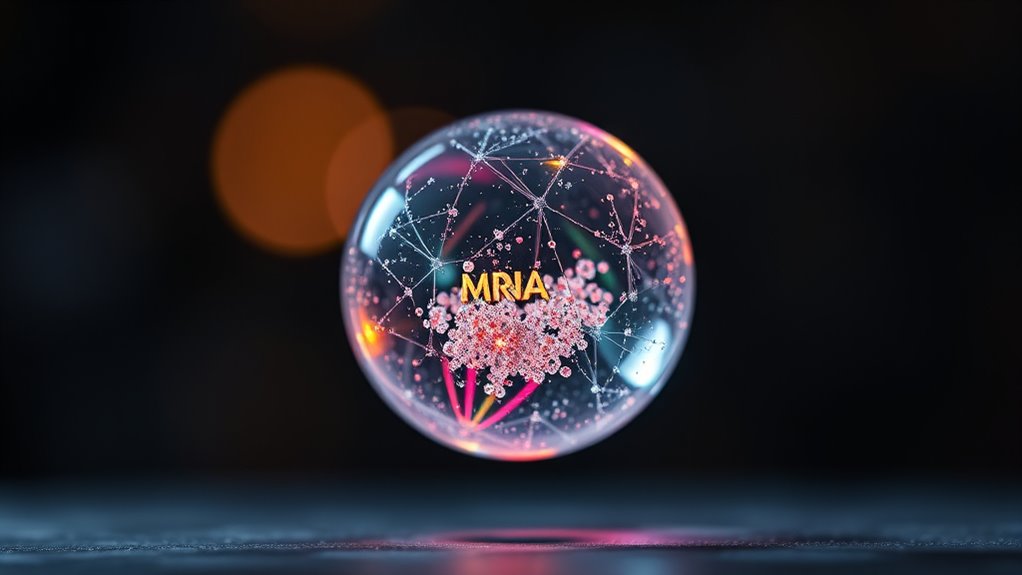
mRNA therapeutics hold great promise for treating a range of diseases by enabling precise protein expression. However, delivering mRNA effectively comes with challenges, especially regarding mRNA stability. You need to protect the fragile mRNA from degradation by enzymes in the bloodstream, ensuring it reaches your target cells intact. Additionally, controlling the immune response is vital; an unintended immune reaction can reduce efficacy or cause side effects. Your goal is to design delivery systems that shield mRNA while avoiding excessive immune activation. Overcoming these hurdles requires careful consideration of how to stabilize mRNA and modulate immune response without compromising safety. Automation technologies can play a role in optimizing delivery methods and quality control processes. Addressing these challenges is essential for realizing the full potential of mRNA therapeutics in clinical applications.
Lipid Nanoparticles: the Pioneers in Mrna Delivery
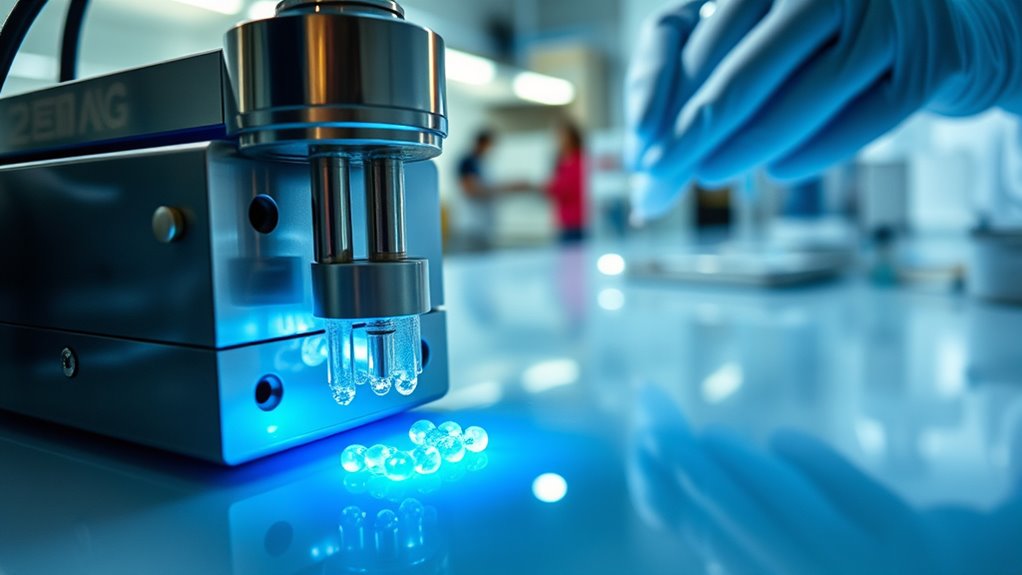
Lipid nanoparticles are at the forefront of mRNA delivery thanks to their adaptable lipid composition and ability to protect fragile mRNA molecules. They employ targeted delivery strategies to reach specific cells, increasing efficiency and reducing side effects. Understanding their design and stability is essential for advancing mRNA therapeutics. Additionally, their high release efficiency enables effective delivery of mRNA payloads into target cells, further enhancing therapeutic outcomes.
Lipid Composition and Stability
Have you ever wondered what makes lipid nanoparticles so effective at delivering mRNA? It all comes down to their lipid composition and how it guarantees stability. The right balance of lipids, like ionizable cationic lipids, phospholipids, cholesterol, and PEG-lipids, creates a stable structure that protects the mRNA from degradation. Lipid composition directly influences particle integrity, fusion capability, and cellular uptake. Stability enhancement is achieved by optimizing these lipids to resist environmental stresses, such as temperature and pH changes, extending shelf life and in vivo effectiveness. Proper lipid formulation guarantees that the nanoparticles remain intact until they reach target cells, where they release their mRNA payload efficiently. This careful balance of lipid components is vital for the success of mRNA delivery systems.
Targeted Delivery Strategies
Targeted delivery strategies have revolutionized how lipid nanoparticles reach specific cells and tissues. By customizing surface modifications, you can enhance the delivery of mRNA for vaccine adjuvants or gene editing. These strategies improve efficacy and reduce off-target effects. Lipid nanoparticles can be directed using ligands, antibodies, or peptides that recognize cell-specific markers. This precision allows for efficient mRNA uptake in desired tissues, minimizing immune responses and side effects.
| Strategy | Key Benefit |
|---|---|
| Ligand conjugation | Targeted cell recognition |
| Antibody attachment | Enhanced specificity |
| Peptide targeting | Improved tissue penetration |
| Surface modifications | Increased stability and delivery |
Utilize these approaches to optimize mRNA therapeutics, making your delivery more precise and effective.
Polymer-Based Nanocarriers for Enhanced Stability

Polymer-based nanocarriers have emerged as a promising approach to improve the stability of mRNA therapeutics, addressing the inherent fragility of mRNA molecules. By protecting mRNA from enzymatic degradation, these carriers extend their half-life and effectiveness. To optimize performance, focus on three key aspects:
- Polymer degradation control: Selecting polymers with tailored degradation rates ensures sustained release and minimizes premature breakdown.
- Nanocarrier customization: Adjusting size, charge, and surface properties enhances stability and cellular uptake.
- Encapsulation efficiency: Improving how well mRNA is loaded safeguards it during delivery and reduces degradation risks.
Additionally, understanding the key components involved in sound design can facilitate the development of more effective nanocarrier systems by drawing parallels with how audio elements are crafted for clarity and engagement.
Through these strategies, polymer-based nanocarriers provide a versatile platform for stabilizing mRNA, ensuring reliable delivery to target cells and improving therapeutic outcomes.
Hybrid Nanocarrier Systems Combining Lipids and Polymers
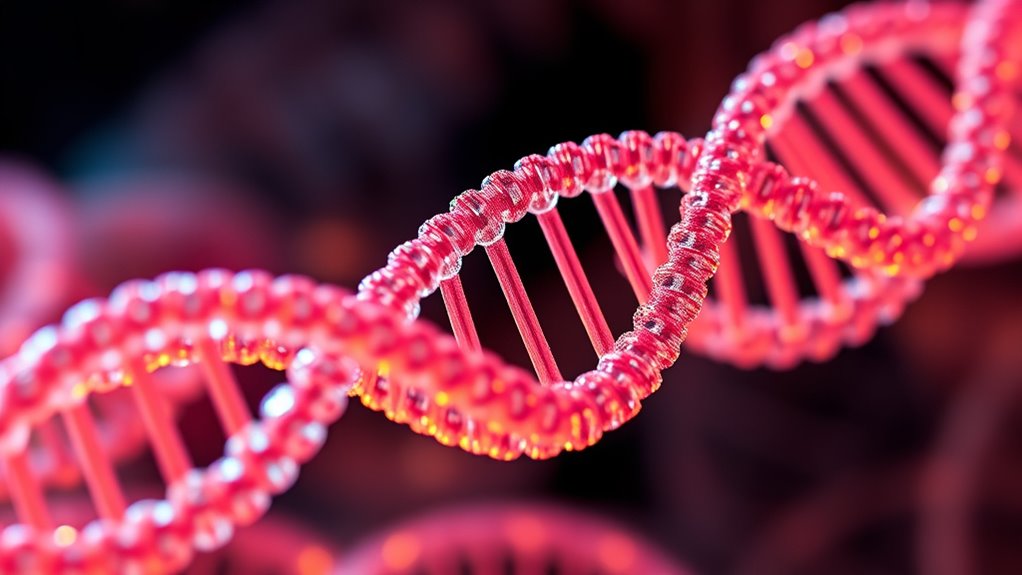
Hybrid nanocarrier systems that combine lipids and polymers offer improved stability and delivery efficiency for mRNA therapeutics. By leveraging the strengths of both materials, you can achieve synergistic benefits that enhance protection and targeting. This approach opens new possibilities for more effective and durable mRNA treatments. Additionally, understanding beginners guides can help optimize formulation and storage conditions for these advanced delivery systems.
Enhanced Stability and Delivery
Combining lipids and polymers in nanocarrier systems enhances the stability and delivery efficiency of mRNA therapeutics. You benefit from improved biocompatibility and safer biodegradation, reducing potential toxicity. Specifically, these hybrid systems offer:
- Enhanced stability through lipid-polymer interactions that protect mRNA from enzymatic degradation.
- Targeted delivery by customizing surface properties for better cell uptake.
- Biocompatibility enhancements using biodegradable materials that minimize immune responses.
This approach prolongs circulation time and ensures more efficient mRNA release at target sites. By integrating biodegradable polymers with lipid components, you create nanocarriers that are both effective and safer, addressing critical stability concerns while maintaining compatibility with biological systems. This synergy boosts overall therapeutic performance and patient safety.
Synergistic Material Benefits
By integrating lipids and polymers into a single nanocarrier system, you harness their complementary properties to achieve superior therapeutic outcomes. This hybrid approach offers synergistic material benefits, combining the biocompatibility and membrane fusion capabilities of lipids with the structural stability and controlled release features of polymers. The nanocarrier synergy enhances mRNA protection, improves cellular uptake, and prolongs circulation time. You get a platform that balances flexibility and robustness, reducing degradation risks and optimizing delivery efficiency. These hybrid systems can be tailored to specific therapeutic needs, maximizing the payload delivery while minimizing side effects. Overall, combining lipids and polymers creates a more versatile and effective nanocarrier, pushing forward the potential of mRNA therapeutics with improved stability, targeting, and performance.
Surface Modifications for Targeted Delivery

Surface modifications play a crucial role in enhancing the specificity and efficiency of nanocarrier systems for mRNA delivery. By employing surface ligand conjugation, you can improve cellular receptor targeting, ensuring the nanocarrier binds precisely to target cells. This process involves attaching specific molecules that recognize and bind to receptors on cell surfaces. You should consider: 1. Selecting ligands that match your target cell receptors. 2. Optimizing conjugation techniques for stable ligand attachment. 3. Ensuring the surface modification doesn’t hinder mRNA stability or release. These strategies enhance targeted delivery, reduce off-target effects, and improve therapeutic outcomes. Effective surface modifications allow your nanocarrier to navigate biological barriers efficiently and deliver mRNA precisely where needed. Additionally, choosing appropriate headphone jacks can facilitate seamless communication between device components, ensuring reliable operation of delivery systems.
Manufacturing Processes and Scalability of Nanocarriers

Manufacturing processes for nanocarriers must be carefully designed to guarantee consistent quality and scalability. To achieve this, you need effective scaling strategies that address the complexities of large-scale production while maintaining nanocarrier integrity. Common manufacturing challenges include ensuring uniform particle size, preventing aggregation, and controlling encapsulation efficiency. You must optimize processes such as microfluidic mixing, solvent evaporation, or nanoprecipitation to minimize variability. Implementing robust quality control measures is essential to meet regulatory standards. Scaling up without compromising safety or efficacy requires balancing process parameters and adopting automation where possible. Overcoming manufacturing challenges ensures that nanocarrier systems can be produced reliably at a commercial scale, enabling broader application of mRNA therapeutics. Additionally, maintaining high-pressure application techniques during production can help achieve consistent coating and encapsulation, further supporting scalability and quality control.
Safety and Biocompatibility Considerations

Ensuring the safety and biocompatibility of nanocarrier systems is essential for their successful application in mRNA therapeutics. You need to take into account how these carriers might trigger an immune response, which could reduce effectiveness or cause adverse effects. Additionally, long-term toxicity is a critical factor; persistent or accumulated materials may harm tissues over time. To address these concerns, focus on: 1. Designing nanocarriers with minimal immune activation by selecting biocompatible materials. 2. Conducting comprehensive toxicity studies to monitor long-term effects. 3. Optimizing clearance pathways to prevent accumulation and reduce potential toxicity. Incorporating AI data analysis can further enhance the prediction of immune responses and toxicity profiles for nanocarriers.
Emerging Innovations and Future Directions
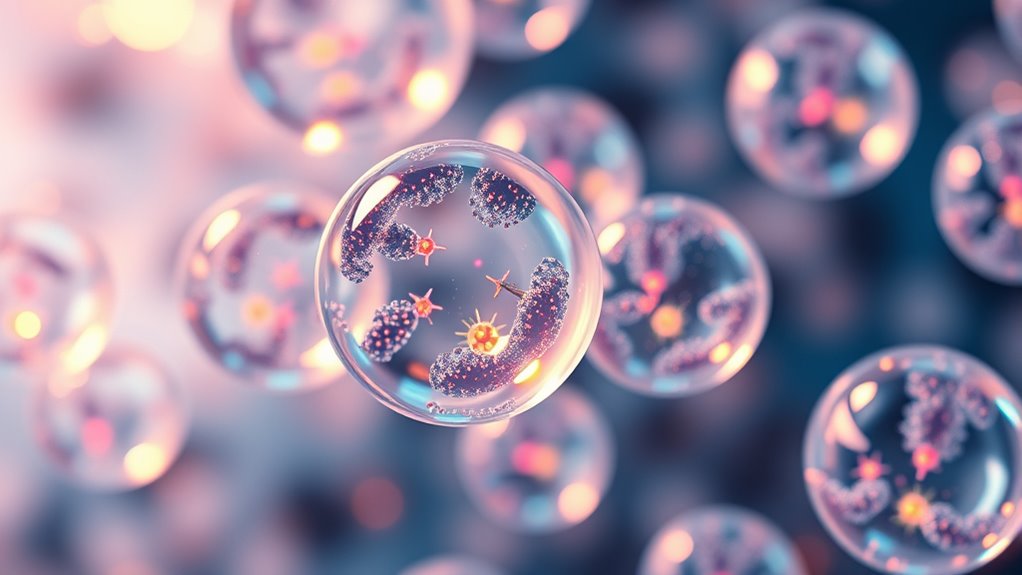
Emerging innovations in nanocarrier systems hold great promise for advancing mRNA therapeutics, paving the way for more effective and targeted treatments. Quantum dots are gaining attention for their imaging capabilities and potential to track nanocarrier delivery in real-time, enhancing precision. Extracellular vesicles offer natural, biocompatible carriers that can cross biological barriers, improving cellular uptake and reducing immune responses. Researchers are exploring hybrid systems combining quantum dots with extracellular vesicles to leverage both imaging and biocompatibility advantages. These innovations aim to optimize delivery efficiency, stability, and targeting accuracy, ultimately improving therapeutic outcomes. As these technologies mature, they could revolutionize mRNA delivery, enabling personalized medicine and expanding applications in vaccine development and gene therapy. The future of nanocarrier systems is bright with these promising developments.
Regulatory Perspectives and Clinical Applications
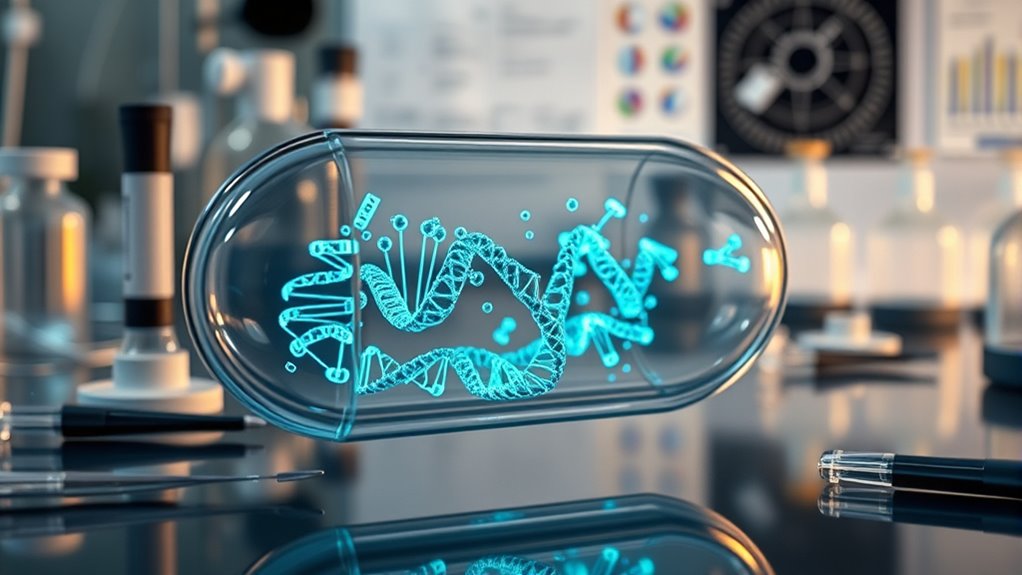
How are regulatory agencies shaping the development and clinical adoption of nanocarrier systems for mRNA therapeutics? They play a pivotal role in ensuring safety, efficacy, and quality through a streamlined approval process. Here’s what you should know:
- Regulatory approval requires exhaustive data from preclinical and clinical trials to demonstrate safety and effectiveness before market release.
- Clinical trials are critical steps; agencies closely monitor these to evaluate nanoparticle delivery systems’ performance and potential risks.
- Agencies are adapting guidelines specifically for nanocarriers, fostering innovation while maintaining strict safety standards.
- The incorporation of analytical and performance cookies in the review process can aid agencies in assessing the efficacy of nanocarrier systems through detailed performance data.
This evolving regulatory landscape influences how quickly and confidently nanocarrier-based mRNA therapies reach patients, ensuring they meet rigorous standards for widespread clinical application.
Frequently Asked Questions
How Do Nanocarrier Systems Influence Mrna Vaccine Storage Stability?
Nanocarrier systems play a vital role in mRNA vaccine storage stability by protecting the mRNA from nanocarrier degradation. You should store these vaccines at specific temperatures because storage temperature effects can impact nanocarrier integrity, potentially leading to degradation and reduced efficacy. Proper temperature control minimizes nanocarrier degradation, ensuring the mRNA remains stable and effective until administration. This emphasizes the importance of strict storage guidelines for maintaining vaccine potency.
What Are the Cost Differences Between Lipid and Polymer-Based Nanocarriers?
Think of lipid and polymer-based nanocarriers like classic versus modern tools—you’ll find lipid systems generally more cost-efficient due to simpler manufacturing processes. Polymer carriers often require more complex, costly production, which can drive up expenses. While polymer nanocarriers might offer customization benefits, their higher manufacturing complexity means they tend to be pricier than lipid-based options, impacting overall vaccine affordability and scalability.
How Do Nanocarriers Affect Mrna Immune Response Modulation?
You’ll find that nanocarriers considerably influence mRNA immune response modulation by enhancing immune evasion and controlling immune activation. They deliver mRNA efficiently to target cells, reducing unintended immune reactions, and can be engineered to include immune-modulatory agents. This balance ensures a robust therapeutic effect while minimizing side effects. Ultimately, nanocarriers help fine-tune immune responses, making mRNA therapeutics safer and more effective for various medical applications.
Can Nanocarriers Deliver Multiple Types of Nucleic Acids Simultaneously?
Think of nanocarriers as versatile delivery trucks capable of multicomponent delivery, bringing different nucleic acids together in perfect harmony. You can design them to carry multiple types of nucleic acids simultaneously, enabling nucleic acid synergy. This approach maximizes therapeutic potential, allowing you to target multiple pathways at once, much like a symphony of genetic tools working in concert, enhancing treatment efficacy and opening new frontiers in personalized medicine.
What Are the Environmental Impacts of Nanocarrier Manufacturing and Disposal?
You should consider that the environmental footprint of nanocarrier manufacturing and disposal can be significant, impacting ecosystems through waste management challenges. Toxic residues or nanoparticles may persist in water and soil, posing risks to wildlife and human health. Proper waste management practices are essential to minimize environmental harm, including recycling and safe disposal methods. Being mindful of these impacts helps reduce potential long-term ecological consequences of nanocarrier production and use.
Conclusion
As you explore nanocarrier systems for mRNA therapeutics, remember that this field is evolving faster than a chariot race. With innovative lipids, polymers, and hybrid designs, you’re on the cusp of transforming medicine—making treatments more targeted and efficient. Stay curious and keep pace with the latest advances, because, just like in the days of Da Vinci, tomorrow’s breakthroughs depend on today’s ingenuity. The future of mRNA delivery is truly a marvel in the making.








